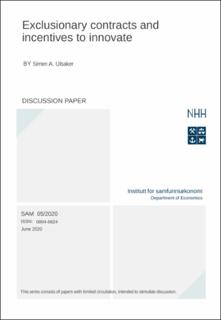| dc.description.abstract | The article considers a situation where several firms have the opportunity to sell an identical product to a set of buyers, and where each seller can invest in R&D to develop a higher quality version of the product in question. I consider the possibility of allowing the sellers to offer exclusionary contracts, prior to deciding how much to invest in R&D. In equilibrium every buyer will sign an exclusionary contract with the same seller. Since all buyers are locked to one seller, only this seller will have an incentive to invest in R&D. Whether or not banning exclusionary contracts increases the aggregate probability of successful innovation depends on the R&D technology. More specifically, banning exclusionary contracts will increase the aggregate probability of innovation and joint surplus of buyers and sellers only when the R&D technology exhibits sufficient diseconomies of scale. | en_US |
